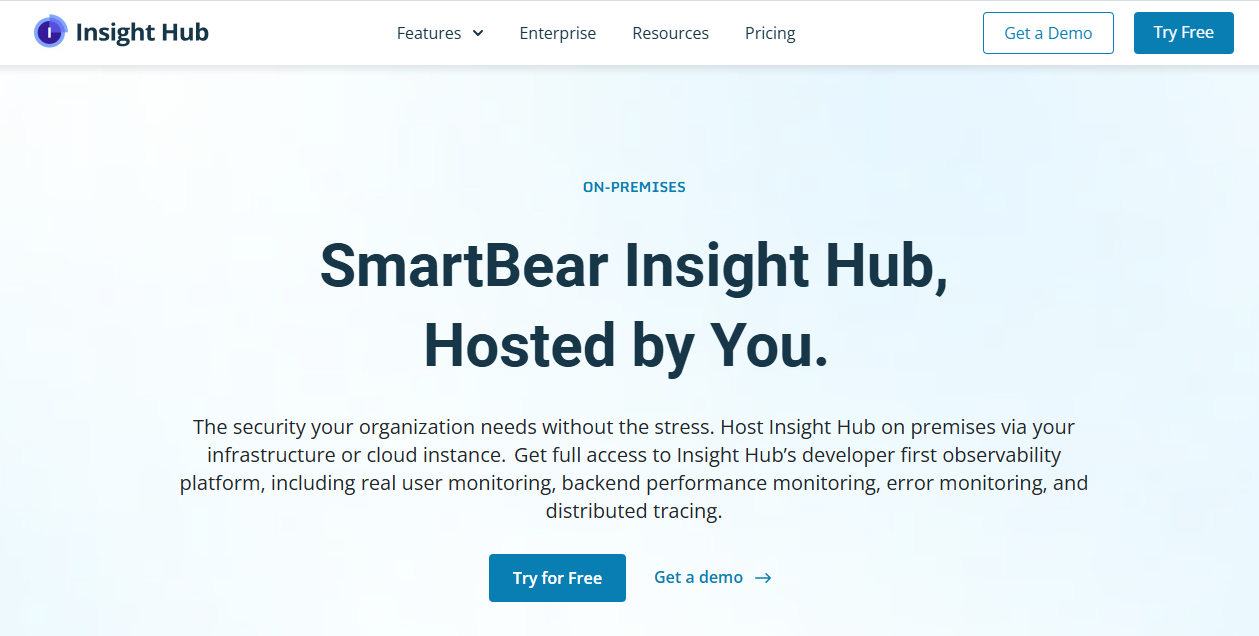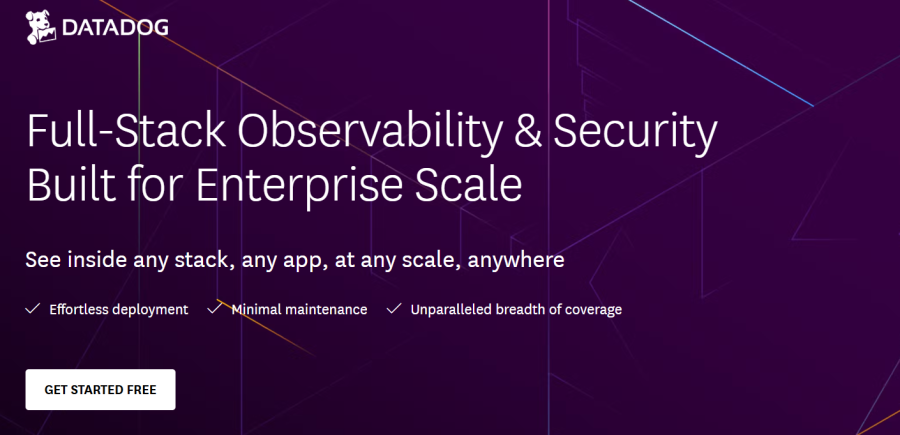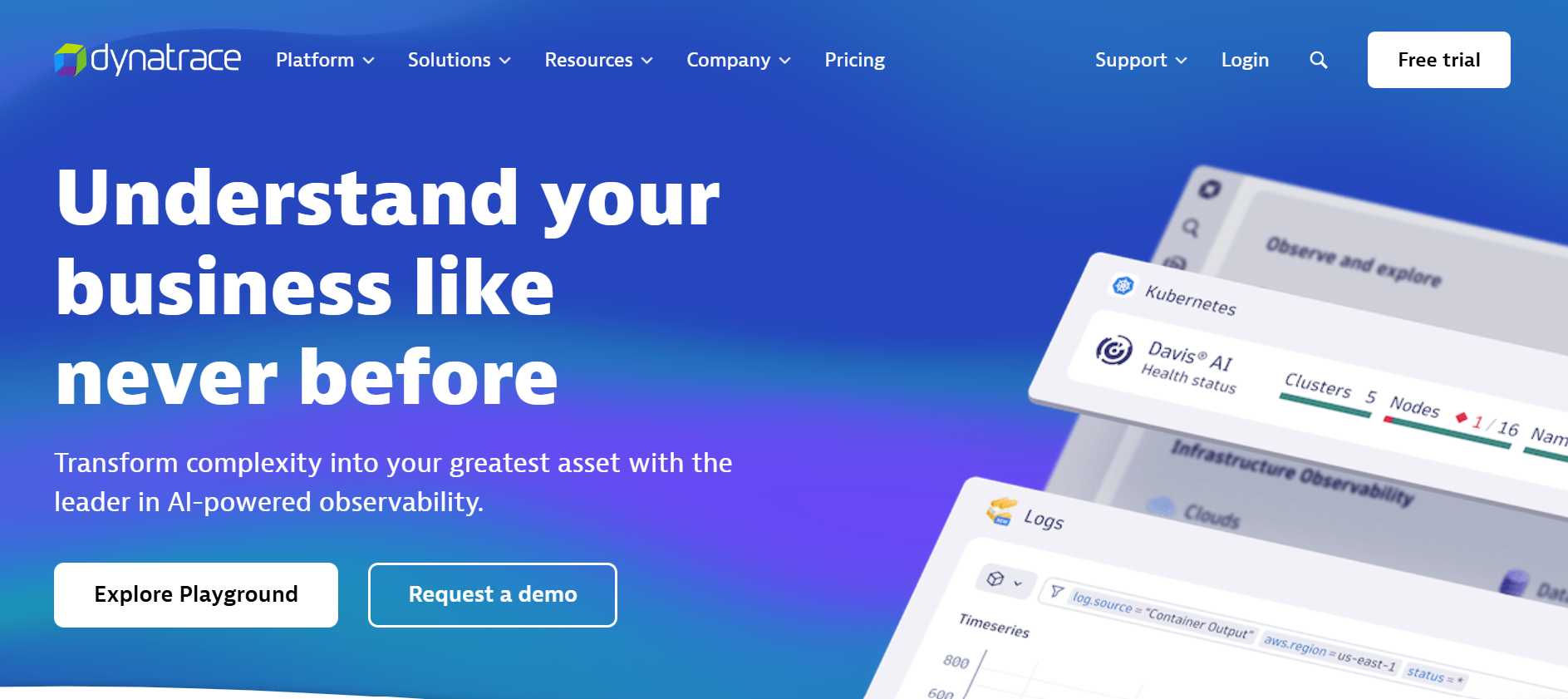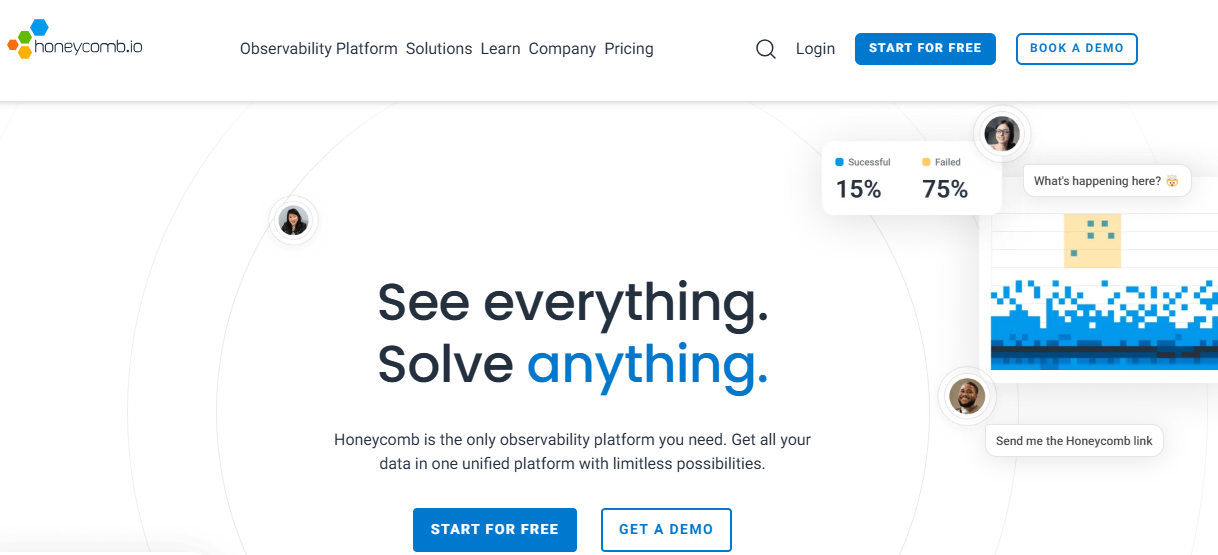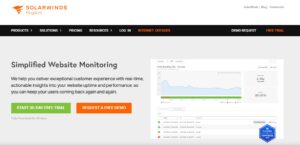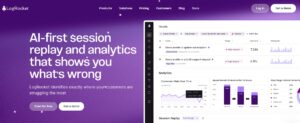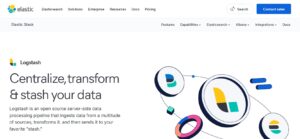Aspecto, founded in 2019, was a modern developer-friendly observability platform focused on OpenTelemetry-based distributed tracing, service dependency mapping, and real-time debugging. SmartBear acquired it in 2023 and folded its tech into BugSnag. In 2025, BugSnag became Insight Hub, adding error monitoring, RUM, backend performance, and tracing.
This broadened scope means Aspecto’s tracing is now just one part of a multi-focus suite, which shifted the product’s focus and structure. It has reduced clarity around feature parity, standalone roadmap, and whether new OTEL-first teams can still adopt it the way early users did. The observability scope remains narrow, primarily focused on tracing, so teams may need additional tools for metrics, logs, RUM, and synthetics.
CubeAPM is the best Aspecto alternative as it remedies these gaps with full MELT support, native OpenTelemetry ingestion, smart sampling for efficient data retention, flexible deployment (self-host or SaaS), transparent pricing, and high-quality support, making it a more comprehensive and economical choice.
In this article, we’ll explore 7 Aspecto alternatives to help you choose the best observability tool for your needs.
Table of Contents
ToggleTop 7 Aspecto Alternatives
- CubeAPM
- Datadog
- Dynatrace
- New Relic
- Grafana
- Honeycomb
- IBM Instana
Why Are People Looking for Aspecto (Insight Hub) Alternatives?
Opaque Pricing and Difficulty Forecasting Costs
Since Aspecto’s acquisition, its original pricing (usage-based) is no longer available on the website. BugSnag’s pricing is based on seats or events for error monitoring, and not per GB of data ingested. Finance/DevOps teams can’t forecast 6–12-month spend without quotes, making capacity planning and approval cycles harder than with vendors that publish $/GB or per-host rates.
Aspecto Costing Example for a Mid-size team
Insight Hub’s paid plans start from $20 for 1M spans, 50k events monthly, and go up to $2234/month for 3M events and 300M spans monthly. However, for a mid-sized business with 10 users handling 10 TB/month of trace data, these limits would be exceeded almost immediately.
To accommodate that volume, you would require either large overage purchases or an Enterprise plan—both of which lack public rates and are known to scale sharply with usage. This means total monthly costs can climb into the several-thousand-dollar range, especially when span overages are billed.
In contrast, alternatives, such as CubeAPM, offer ingested-based pricing of $0.15/GB
Cost → $0.15 * 10 TB ≈ $1,500 per month for unlimited users.
No Longer Standalone OTEL-Native
Aspecto was originally designed as a fully OTEL-native tracing platform, built from the ground up to ingest and process OpenTelemetry data without proprietary constraints. Since its March 2023 acquisition by SmartBear and integration into BugSnag/Insight Hub, tracing is now just one feature inside a broader error-monitoring suite.
While Insight Hub supports OTEL traces, it is not OTEL-native in the same way Aspecto was—its architecture and roadmap are primarily focused on error events, release tracking, and debugging workflows. This shift reduces the vendor-neutral flexibility and deep OTEL observability capabilities that originally drew many engineering teams to Aspecto.
Incomplete MELT Coverage
Insight Hub’s observability suite, though enriched by integrated Aspecto tracing, explicitly highlights error monitoring, real user monitoring (RUM), and distributed tracing as its core pillars—there is no emphasis on metrics or log collection, nor on synthetic monitoring or event analytics in its documentation or product descriptions.
As a result, organizations seeking the full MELT experience—metrics, events, logs, and traces—in a unified platform still need to adopt additional tools for metrics dashboards, log management, and synthetic testing. This fragmented stack leads to higher costs, more complex alerting configurations, and longer resolution cycles when diagnosing issues across telemetry types.
Limited Deployment Options and Compliance Clarity
Insight Hub is a SaaS solution, primarily. While SmartBear offers enterprise and on-prem hosting in parts of its portfolio, there is no publicly available, Aspecto-specific documentation outlining private cloud or air-gapped deployments, regional data residency controls, or detailed compliance workflows. For regulated industries like finance, healthcare, and government, this lack of transparency complicates audits and procurement.
Lack of Advanced Sampling
Insight Hub does offer built-in sampling mechanisms:
- It uses dynamic managed/unmanaged span quotas with the ability to automatically adjust sampling probabilities to stay within daily limits. This helps control span volume but lacks fine-grained control over which traces are prioritized.
- With OpenTelemetry, you can use head-based sampling (e.g., parent-based) for fixed-rate control, or implement tail-based sampling via OpenTelemetry collectors—allowing full-trace evaluation before sending—but only if you deploy and configure a collector on your infrastructure.
While Insight Hub provides basic managed sampling, it does not offer a built-in, fully managed smart sampling system that automatically preserves anomaly-linked traces.
Roadmap and Support Alignment Changes
Tracing within Insight Hub now shares a roadmap, release cadence, and support resources with the error-monitoring product. This alignment risks deprioritizing trace-specific features and integrations in favor of error-tracking enhancements, which may not align with the needs of OTEL-focused engineering teams.
Criteria for Selecting Aspecto Alternatives
Native OpenTelemetry (OTEL) support
An ideal alternative should fully support OTEL ingestion, processing, and querying without forcing proprietary agents or formats. This ensures vendor neutrality, easier migration, and the ability to reuse existing instrumentation. Platforms with OTEL-native pipelines also integrate more seamlessly with modern microservices architectures.
Full MELT coverage
Look for a platform that delivers the complete MELT stack—metrics, events, logs, and traces—in a unified interface. This reduces tool sprawl, streamlines troubleshooting, and enables cross-signal correlation (e.g., linking a spike in latency with a specific infrastructure event and error trace).
Flexible deployment options
Compliance-heavy industries require deployment models beyond SaaS, including private cloud, self-hosted, or fully air-gapped setups. A strong alternative should provide multiple hosting options with documented data residency controls and the ability to meet HIPAA, GDPR, and industry-specific regulations.
Transparent and predictable pricing
Alternatives should publish clear cost structures—such as $/GB ingestion or per-host rates—along with retention tiers and add-on costs for modules like synthetics or RUM. Transparent pricing allows teams to model 6–12 months of usage and prevents unexpected overages.
Advanced sampling strategies
Efficient cost control depends on sampling that retains high-value traces—such as those linked to anomalies, latency spikes, or error patterns—while discarding redundant data. Look for tail-based or context-aware sampling capabilities, ideally with policies that can be tuned per service or environment.
Integration ecosystem
An alternative should offer compatibility with widely used tools like Prometheus, Grafana, major cloud providers, CI/CD pipelines, and incident management systems. This reduces friction during migration and ensures observability data flows into existing workflows.
Performance and scalability
Low-latency ingestion and querying are critical for real-time troubleshooting. The platform should handle large telemetry volumes (e.g., 10 TB/month or more) without performance degradation, while maintaining high availability across regions.
Support quality and roadmap visibility
Reliable support channels (chat, ticket, Slack) with documented SLAs are essential. Roadmap transparency ensures customers know how the product will evolve and whether it aligns with their long-term observability strategy.
Insight Hub Overview
Known for
Insight Hub (formerly BugSnag, with integrated Aspecto tracing) is known as SmartBear’s unified observability and application stability platform. It combines error monitoring, real user monitoring (RUM), backend performance insights, and distributed tracing into a single interface, aimed at helping engineering teams identify, prioritize, and resolve production issues quickly.
Standout Features
- Error Stability Scoring: Tracks application health over time by calculating stability scores for each release.
- Integrated Distributed Tracing: Incorporates Aspecto’s OTEL-based tracing to connect backend transactions with frontend error data.
- Real User Monitoring (RUM): Monitors user sessions for errors, performance metrics, and stability impact.
- Release & Version Tracking: Links stability metrics and errors directly to specific releases for faster rollback or remediation.
- Cross-Platform Support: Works with web, mobile, and backend applications, supporting multiple frameworks and languages.
Key Features
- Error Monitoring & Alerting: Captures unhandled exceptions, performance issues, and error trends with real-time notifications.
- RUM & Session Insights: Tracks page load time, navigation timing, and error impact on user experience.
- Distributed Tracing Support: Integrates tracing data to connect application errors with related backend spans.
- Version & Deployment Insights: Monitors stability scores and errors per release to assess the impact of new deployments.
- Collaboration Tools: Integrates with Slack, Jira, GitHub, and other developer tools for incident workflow automation.
- API & SDK Availability: Offers language-specific SDKs for fast integration and customization.
Pros
- Unified interface for error monitoring, RUM, and tracing.
- Clear release-based stability tracking.
- Strong integration ecosystem with developer workflow tools.
- Supports multiple platforms and frameworks.
- Real-time alerts for high-priority production issues.
Cons
- Limited MELT coverage—no native logs, metrics dashboards, or synthetic monitoring
- Primarily SaaS; on-premises deployments limited to enterprise contracts
- Lacks built-in advanced sampling—requires external OTEL collector for tail-based sampling
- Pricing transparency is low for high-ingestion workloads
- Roadmap prioritizes error monitoring over OTEL observability features
Best for
Engineering teams that prioritize error tracking, real user monitoring, and basic distributed tracing in one platform, particularly those already using SmartBear products. Well-suited for web, mobile, and backend applications that need stability scoring and release insights, but less ideal for organizations seeking full-stack MELT observability in a single tool.
Pricing & Customer Reviews
- Free: 1 user, 7.5k events, 1M spans/month
- Select: $20/month, unlimited users
- Preferred: $33/month, unlimited users
- Enterprise: Custom pricing with on-premises and advanced features
- G2 rating: 4.3/5 (32 reviews)
- Praised for: real-time error detection, robust filtering and tracking, helpful error dashboards.
- Criticised for: limited MELT coverage, opaque pricing for high-volume tracing
Top 7 Aspecto Alternatives
1. CubeAPM
Known for
CubeAPM is recognized as an OpenTelemetry-native observability platform built for complete MELT (Metrics, Events, Logs, Traces) visibility, cost efficiency, and flexible deployment. It excels at enabling teams to retain valuable telemetry without ballooning storage costs, thanks to advanced smart sampling.
Standout Features
- Context-Aware Smart Sampling: Dynamically retains traces based on anomalies like high latency, error spikes, or abnormal span durations—cutting data volume by up to 80% while preserving investigative depth.
- Broad Agent Compatibility: Natively integrates with agents from Datadog, New Relic, Prometheus, and Elastic, streamlining migration without re-instrumentation.
- Rapid Deployment: Operational in under an hour with no complex SDK setup or manual code changes.
- Direct-to-Engineer Support: Offers Slack or WhatsApp access to core engineers with response times often under five minutes, minimizing MTTR.
Key Features
- Unified MELT Stack: End-to-end observability from a single interface, covering logs, metrics, traces, RUM, synthetics, and error tracking.
- Native OTEL Support: Full OTLP ingestion for all telemetry signals, ensuring interoperability and avoiding vendor lock-in.
- Transparent Usage-Based Pricing: Single $/GB rate with no per-host or per-user fees, plus built-in cost controls.
- Flexible Deployment Models: Supports SaaS, on-premises, and air-gapped hosting with compliance readiness for HIPAA, GDPR, and other regulations.
- Ready-to-Use Dashboards: Auto-generated visualizations for Kubernetes, infrastructure, databases, and application performance.
- Enterprise-Grade Security: Features SSO, RBAC, tenant isolation, and detailed audit trails for secure collaboration.
Pros
- 800+ integrations and strong ecosystem compatibility
- No egress fees or hidden charges
- Fully OTEL-compliant with zero vendor lock-in
- Predictable costs with ingestion-based pricing
- Exceptionally fast and accessible technical support
- Advanced sampling keeps costs low without losing critical data
- Meets stringent regulatory compliance requirements
Cons
- Not designed for teams seeking bundled cloud security tooling
- Self-managed hosting may be less appealing for teams preferring pure SaaS
Best for
CubeAPM is suitable for development teams that run microservices-based architectures. It’s especially suited for organizations demanding full MELT coverage, strict compliance, advanced cost control, and high-performance troubleshooting in production-scale systems.
Pricing & Customer Reviews
- Pricing: $0.15/GB of data ingested, inclusive of infra, logs, traces, synthetics, RUM, and error tracking
- Score: 4.7/5
- Praised for: transparent pricing, quick deployment, and industry-leading Slack-based support
CubeAPM vs Insight Hub
While Insight Hub combines error monitoring, RUM, and basic tracing, CubeAPM delivers full MELT observability with native OTEL support, deep sampling control, and flexible deployment. It also offers transparent pricing without user or span quotas, making it significantly more predictable and cost-efficient for high-ingestion environments.
2. Datadog
Known for
Datadog is a major player in cloud-native observability and security, built to give engineering teams a single place to monitor infrastructure, applications, user experience, and security posture. With its wide ecosystem of native integrations and strong presence in AWS, GCP, Azure, Kubernetes, and CI/CD environments, it’s a go-to choice for DevOps and SecOps teams that need consolidated visibility across hybrid and multicloud deployments.
Standout Features
- Extensive Integration Network: Supports over 900 prebuilt integrations with cloud services, runtimes, and databases, enabling plug-and-play deployment in most environments.
- Collaborative RCA Tools: Notebooks allow engineers to correlate logs, metrics, and traces in one view, annotate findings, and share investigations in real time.
- Full-stack Observability and security: You’ll get performance monitoring alongside threat detection, audits, and vulnerability scanning.
- Session Replay in RUM: Provides full playback of user interactions to debug frontend issues with complete context.
- Serverless Visibility: Datadog tracks cold starts, latency, and errors for AWS Lambda, GCP Cloud Functions, and Azure with little to no overhead.
Key Features
- MELT Coverage: The tool covers metrics, events, logs, traces, synthetics, and RUM for deeper analysis.
- Auto-Instrumentation for Multiple Languages: Lightweight agents for Java, Python, Go, Node.js, .NET, and more capture telemetry with minimal code changes.
- Cloud-Native Optimization: Deep integrations with Kubernetes, ECS, Lambda, Azure Monitor, and GCP Stackdriver for dynamic workloads.
- Built-in Security Telemetry: Surfaces vulnerabilities and compliance gaps alongside performance metrics in the same interface.
- CI/CD Integration: Links errors and regressions to commits, builds, or pull requests for faster rollback decisions.
- Highly Customizable Dashboards: Drag-and-drop widgets allow tailored monitoring views for different teams.
Pros
- Broadest integration catalog in the observability market
- Provides security and observability, both
- RCA-friendly tools for collaborative debugging
- Exceptional support for Kubernetes, serverless, and multicloud
- AI-powered anomaly detection reduces alert fatigue
Cons
- Complex and unpredictable pricing, particularly for high data volumes
- No option for full-on-prem deployment
- Not OTEL-native—relies on proprietary agents and formats
- Head-based sampling may overlook certain trace anomalies
- Lower-tier plans may have slower or less personalized support
Best for
Datadog is ideal for fast-scaling organizations running containerized, serverless, or microservices workloads across multiple clouds. Its mix of observability and security capabilities supports close collaboration between DevOps and SecOps teams, and its extensive integrations make it well-suited to complex, fast-changing environments, provided teams can manage its cost structure.
Pricing & Customer Reviews
- Infrastructure Monitoring: $15–$34 per host/month
- APM: $31–$40 per host/month (annual); $36 on-demand
- Logs: $0.10/GB of data ingested
- Serverless: $10 per million invocations
- Security Tools: $15–$40 per user/month
- G2 rating: 4.4/5 (based on 630+ reviews)
- Praised for: plenty of integrations, useful dashboards, full coverage for observability
- Criticised for: cost unpredictability, lack of OTEL-native support, absence of self-hosted deployment
Datadog vs Insight Hub
Datadog offers broader MELT coverage, more integrations, and integrated security compared to Insight Hub’s primary focus on error monitoring, RUM, and tracing. However, Datadog’s ingestion-based pricing can escalate rapidly, making it less predictable for large-scale workloads, whereas Insight Hub’s usage is constrained mainly by span/event quotas.
3. Dynatrace
Known for
Dynatrace is a high-end enterprise observability and application security solution recognized for merging MELT telemetry with AI-driven automation. Its signature capability lies in the Davis AI engine, which continuously ingests massive volumes of signals to detect anomalies, map dependencies, and pinpoint root causes without the need for manual configuration. This makes it especially attractive to large organizations that demand zero-touch monitoring, high uptime SLAs, and advanced troubleshooting at scale.
Standout Features
- Smartscape Real-Time Mapping: Auto-discovers and visualizes applications, services, dependencies, and infrastructure relationships as they evolve.
- Davis AI Analysis Engine: Correlates signals across metrics, logs, traces, and user data, automatically filtering noise and surfacing the root cause in seconds.
- Built-In Runtime Security: Incorporates runtime application self-protection (RASP) to detect vulnerabilities, exploits, and insecure configurations without requiring extra agents.
- Combined RUM and Synthetic Testing: Integrates synthetic transaction tests with real user monitoring to provide a unified view of digital experience.
Key Features
- MELT: The tool consolidates metrics, logs, events, traces (MELT) and RUM and synthetics, which means full-stack observability.
- OneAgent Auto-Instrumentation: Automatically detects services, APIs, and dependencies—no code changes or manual tagging required.
- Real-Time End-to-End Tracing: Links user actions to backend services, methods, or infrastructure for precise troubleshooting.
- Cloud and Kubernetes Native: Provides pod-level and deployment-level observability for Kubernetes, plus deep integration with AWS, Azure, and GCP.
- Integrated Application Security: Monitors vulnerabilities and code-level risks in real time, bringing security into traditional APM workflows.
- Enterprise-Grade Scalability: Optimized for large hybrid or multicloud deployments with automated agent scaling and centralized policy controls.
Pros
- Industry-leading AI-powered root cause detection
- Seamless auto-instrumentation across diverse tech stacks
- Provides performance observability with application security
- Visual Smartscape mapping makes complex environments easy to navigate
- All-in-one MELT coverage reduces reliance on multiple vendors
Cons
- Cost estimation for DDU-based pricing is difficult
- No native OTEL support; limited open-standards flexibility
- Closed architecture may pose migration challenges from open-source tools
- Primarily SaaS-delivered, with limited self-hosted deployment options
Best for
Dynatrace is most suitable for large enterprises and platform teams running mission-critical workloads across hybrid and multicloud environments. It’s a strong fit when real-time AI incident triage, zero-touch instrumentation, and integrated security are top priorities, and when the organization can accommodate its pricing model and proprietary ecosystem.
Pricing & Customer Reviews
- Full-Stack Monitoring: $0.08 per 8 GiB host/hour
- Infrastructure Monitoring: $0.04 per host/hour
- Kubernetes Monitoring: $0.002 per pod/hour
- RUM: $0.00225 per session
- Synthetic Monitoring: $0.001 per HTTP test
- App Security: $0.018 per 8 GiB host/hour
- G2 rating: 4.5/5 (based on 1,300+ reviews)
- Praised for: powerful AI-driven insights, automation, and scalability for hybrid environments
- Criticised for: unpredictable pricing, closed ecosystem, and steep onboarding curve
Dynatrace vs Insight Hub
Dynatrace offers broader MELT support than Insight Hub, in addition to AI-based root cause analysis (RCA) and app security functionalities. However, Insight Hub’s simpler pricing and OTEL-based tracing integration may appeal to teams wary of Dynatrace’s proprietary architecture and complex cost model.
4. New Relic
Known for
New Relic is a cloud-based observability platform tailored for developers, SREs, and DevOps teams running complex, microservices-oriented applications. It provides full-stack MELT visibility, rapid onboarding through native integrations, and deep analysis via its proprietary New Relic Query Language (NRQL). Its strength lies in enabling teams to quickly visualize, query, and correlate telemetry data in real time for both debugging and performance optimization.
Standout Features
- Explorer View for Dependency Mapping: Automatically generates live service maps of applications, infrastructure, and upstream/downstream dependencies to accelerate troubleshooting.
- NRQL-Driven Data Exploration: Leverages the New Relic Query Language for real-time, custom filtering and aggregation across metrics, traces, and logs.
- Lookout ML Anomaly Detection: Uses machine learning baselines to surface anomalies in latency, error rates, and throughput while reducing false alerts.
- Advanced Dashboarding: Allows fine-grained customization of dashboards and visual widgets, enabling role-specific and executive-level reporting.
Key Features
- MELT: The tools can correlate metrics, traces, logs, RUM, synthetics, and events under one data model.
- Agent-Based Auto-Instrumentation: Supports a broad set of programming languages (Java, Python, Ruby, Node.js, Go, .NET) for fast backend integration.
- Cloud & DevOps Integration: Native connectors for AWS, Azure, GCP, Kubernetes, GitHub, and Jenkins to link telemetry directly to deployment events.
- Real User & Synthetic Monitoring: Captures live user sessions alongside synthetic flows to proactively identify performance degradation.
- AI-Powered Baselines: Learns expected behavior patterns over time, improving alert accuracy and reducing noise.
- Fast SaaS Deployment: Minimal configuration required—teams can begin monitoring within minutes of agent installation.
Pros
- Flexible NRQL querying for precise, ad hoc data analysis
- Highly customizable dashboards for multi-team or leadership use
- Rapid onboarding and quick time-to-value via native integrations
- Automatic service mapping simplifies navigating distributed systems
- Strong ecosystem of cloud and CI/CD integrations
Cons
- SaaS-only delivery limits deployment in compliance-restricted environments
- Pricing complexity from ingestion, user roles, and feature add-ons
- Partial OTEL-native compatibility, requiring mapping or sidecars for full use
- Relies on head-based sampling by default, potentially missing rare issues
- Support response times can lag during urgent incidents
Best for
New Relic is well-suited for SaaS-first engineering teams, platform operations groups, and organizations seeking rapid setup with powerful querying and visualization. It’s particularly effective for CI/CD-aware observability, anomaly detection, and real-time production debugging, provided the team is comfortable with a cloud-only model and dynamic, usage-based pricing.
Pricing & Customer Reviews
- Free Tier: 100 GB/month ingest, 1 core user
- Ingestion: $0.35–$0.55/GB based on retention
- Core User: $49/user/month
- Full Platform Access: $99–$418/user/month, based on features
- G2 rating: 4.4/5 (500+ reviews)
- Praised for: customizable dasboards, query engine performance, easy onboarding
- Criticised for: unpredictable costs, no self-hosted option, and partial OTEL-native integration
New Relic vs Insight Hub
New Relic delivers far deeper MELT observability, a powerful query language, and richer dashboard customization compared to Insight Hub. However, Insight Hub’s OTEL-native tracing and potentially simpler cost structure may appeal to teams avoiding complex SaaS pricing or those requiring deployment flexibility.
5. Grafana
Known for
Grafana is an open-source observability and visualization solution. It’s known for its support for open standards and a huge integration ecosystem. It empowers teams to create fully customized dashboards and connect disparate telemetry sources, often leveraging Prometheus, Loki, and Tempo for a complete MEL observability stack under their own control.
Standout Features
- Native OTEL: Grafana integrates natively with OpenTelemetry via Prometheus, Loki, and Tempo for you to visualize data across different data types.
- Integrated Loki & Tempo Backends: Offers built-in log and trace storage engines that connect directly to the Grafana interface, minimizing extra tooling requirements.
- Deployment options: You can run it either as open-source software or deploy it on-premise through Grafana Enterprise or Cloud.
- Advanced Alerting: Supports alert routing, silencing, and escalation policies, with optional OnCall integration for incident response.
Key Features
- Powerful Time-Series Visualization: Delivers rich panels, graphs, gauges, and heatmaps for spotting patterns and anomalies in metrics.
- Compatibility: Offers native support for Tempo, Prometheus, and Loki, which allows teams to easily control their data ingestion, analysis, and storage.
- Plenty of Plugins & Dashboards: The tool offers a large marketplace of plugins for databases, cloud platforms, etc.
- Multiple Hosting Models: Choose from OSS (free), Grafana Cloud for managed hosting, or Enterprise with enhanced features and SLAs.
- Granular RBAC: Define permissions at the team, folder, and dashboard level to enforce security policies.
- Alert Rule Builder: You can build alerts and route them to apps, such as Slack, email, PagerDuty, or webhooks.
Pros
- Free, open-source foundation with strong OTEL support
- Highly customizable dashboards and plugin-based extensibility
- Multiple hosting options to fit regulatory or scaling needs
- Deep integration with Prometheus, Loki, and Tempo
- Backed by a large and active open-source community
Cons
- Requires manual setup, scaling, and backend optimization
- Missing built-in RUM, synthetic checks, and security observability
- No native anomaly detection or advanced sampling features
- OnCall and some advanced alerting tools are behind paid plans
Best for
Grafana is more suitable for DevOps teams and engineering teams looking for a platform that offers great flexibility plus vendor neutrality. It’s especially suited to those comfortable operating Prometheus, Loki, and Tempo independently while prioritizing visualization and customization over turnkey automation or bundled APM features.
Pricing & Customer Reviews
- Grafana OSS: Free
- Grafana Cloud: Free for 10,000 active series
- Pro Tier: From $19/month
- Enterprise: Custom quotes based on scale/support
- G2 rating: 4.5/5 (130+ reviews)
- Praised for: powerful visualization, flexible deployment options, strong open-source community
- Criticised for: manual scaling, no RUM, basic features in the free plan
Grafana vs Insight Hub
Grafana provides unmatched visualization flexibility and native OTEL integration, enabling teams to craft custom observability environments. Insight Hub, however, may offer a simpler, more consolidated experience for organizations that want fewer moving parts and built-in ingestion pipelines without managing backend complexity.
6. Honeycomb
Known for
Honeycomb is recognized as an “observability-first” platform tailored for SREs and developers who need to deeply query and understand complex, event-driven systems. It emphasizes high-cardinality, real-time data exploration, and empowers teams to ask ad-hoc questions of their telemetry with minimal setup.
Standout Features
- High-Cardinality Query Engine: Designed to handle multi-dimensional, high-cardinality data without pre-aggregation, making mystery debugging and deep exploration lightning-fast.
- Event-Centric Exploration UI: Interactive filtering and “bubble-up” workflows allow users to pivot through traces, traces events, and metadata in real-time.
- Heatmap-Based Visual Insights: Visualizes performance distributions via heatmaps and flamegraphs to highlight anomalies and performance regressions over time.
Key Features
- Ad-Hoc Trace & Event Analytics: Enables deep querying across events, spans, and custom fields without much upfront indexing or schema definitions.
- Real-Time Interaction Feedback: Enables instant feedback on queries, supporting rapid hypotheses and live debugging during incidents.
- Compact Collaboration: Shared queries, dashboards, and annotations keep teams aligned during incident resolution.
- Scalable OLAP-Style Storage: Optimized for rapid access to high-cardinality data, combining compression with performance.
- SaaS-Based Delivery: Fully managed service that offloads telemetry storage, scaling, and infrastructure management from users.
Pros
- Exceptional for exploring complex, high-cardinality datasets
- UI supports deep, iterative investigation workflows
- Real-time performance analysis accelerates root cause identification
- Strong collaboration features are embedded within the UI
Cons
- No native MELT suite—limited metrics, logs collection, and no built-in synthetics or RUM
- Fully SaaS-only offering—not suitable for on-prem or self-hosted deployments
- Pricing structure can become very costly at scale, given high-resolution data requirements
- Has a learning curve while visualizing results and framing queries
Best for
Honeycomb is ideal for development, SRE, and platform teams managing event-rich, distributed microservices that require fine-grained, real-time observability. It shines in environments where ad-hoc querying, multi-dimensional troubleshooting, and seamless collaboration are more valuable than prebuilt dashboards or consolidated MELT stacks.
Pricing & Customer Reviews
- Free: for 20 million events/month
- Paid: Starts $130/month for 100M events
- Enterprise: Custom
- G2 rating: 4.7/5 (15 reviews)
- Praised for: intuitive event exploration, powerful heatmap visuals, and flexible ad-hoc debugging workflows (based on community feedback).
- Criticised for: steep costs at high cardinality, lack of full observability stack features, and challenges with query learning curve.
Honeycomb vs Insight Hub
Honeycomb excels at interactive, high-cardinality event and trace exploration within distributed systems, offering unmatched investigation workflows. Insight Hub, on the other hand, packages tracing with error monitoring, RUM, and release insights—better suited to teams wanting a consolidated pipeline with less manual querying overhead.
7. IBM Instana
Known for
IBM Instana is known for delivering AI-assisted observability with automatic service discovery, real-time topology mapping, and flexible deployment across SaaS or self-hosted environments. It’s built to monitor applications, containers, and infrastructure end-to-end while supporting compliance-heavy industries through on-prem and hybrid options.
Standout Features
- Causal AI-Powered Incident Detection: Uses causality-based machine learning to identify the true root cause of incidents rather than just correlated dependencies, reducing noise and accelerating resolution.
- Continuous Auto-Mapping: Automatically discovers services, APIs, containers, and infrastructure nodes to maintain an always-up-to-date system topology.
- AI-Driven Remediation Guidance: Leverages Watsonx.ai automation to provide resolution recommendations based on historical fixes and known incident patterns.
Key Features
- Full MELT Observability: Combines metrics, events, logs, traces, RUM, and synthetic monitoring in a single interface for unified visibility.
- End-to-End Stack Coverage: Supports applications, microservices, Kubernetes clusters, and VMs with minimal manual configuration.
- OpenTelemetry Integration: Connects to OTEL collectors for enhanced interoperability while still offering native instrumentation.
- Automated Baseline Learning: Establishes performance baselines and triggers anomaly alerts when deviations are detected, helping to reduce false positives.
- Granular Session Monitoring: Captures detailed real user session data to identify frontend issues in real time.
- Deployment Flexibility: Offers both cloud-hosted and self-managed deployment modes to meet data sovereignty and compliance needs.
Pros
- Accelerates mean-time-to-resolution with automated root cause detection
- Minimal setup thanks to automatic mapping and instrumentation
- Intelligent remediation suggestions reduce manual troubleshooting effort
- Supports both SaaS and self-hosted deployments for regulated industries
- Well-rated for ease of use and responsive customer support
Cons
- Cost can escalate in microservices-heavy deployments due to per-host pricing
- Limited native OTEL capabilities compared to open-source-first platforms
- UI may slow down in very large-scale environments
- Sampling features unavailable in lower-tier SaaS editions
- First-line support sometimes routed via resellers, adding response delays
Best for
IBM Instana is a strong choice for mid-to-large enterprises, SRE teams, and platform engineering groups that require automated discovery, AI-powered troubleshooting, and flexible deployment options. It’s especially suited to hybrid or compliance-focused environments where both observability depth and deployment control are essential.
Pricing & Customer Reviews
- Essentials: $20 per host/month
- Standard: $75 per host/month
- G2 rating: 4.4/5 (396+ reviews)
- Praised for: intuitive user interface, quick setup, and strong customer support
- Criticized for: performance issues, no sampling in lower plans, no OTEL, scaling cost
IBM Instana vs Insight Hub
IBM Instana focuses on automated discovery, real-time dependency mapping, and AI-powered root cause detection across the full MELT stack, with the flexibility of both SaaS and self-hosted deployment. It’s suitable for hybrid as well as compliance-heavy environments. In contrast, Insight Hub (formerly Bugsnag) is specialized for application stability monitoring, error tracking, and release health analytics, primarily targeting frontend and mobile teams.
Conclusion: What’s the best CubeAPM is the Best Aspecto Alternative
Aspecto—now Insight Hub—offers valuable release health and error tracking, but its scope is narrow. Teams often face gaps in full-stack observability, MELT coverage, deployment flexibility, and cost transparency. Many also seek deeper infrastructure insights, native OpenTelemetry pipelines, and advanced sampling—areas where Insight Hub falls short.
CubeAPM addresses these challenges head-on with complete MELT observability, 100% OTEL-native ingestion, smart context-aware sampling that cuts costs by up to 80%, and self-hosting. It delivers real-time dashboards, enterprise-grade compliance, and ultra-fast engineer-to-engineer support.
If you’re looking for the best Aspecto/Insight Hub alternative and a future-ready observability stack, try CubeAPM for high performance, transparency, and control without vendor lock-in.

